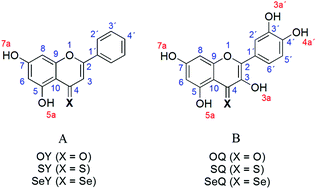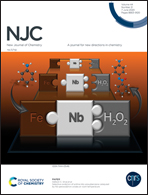Chalcogen effects on the primary antioxidant activity of chrysin and quercetin†
Abstract
The effect of chalcogens on the scavenging power of chrysin and quercetin antioxidants against peroxyl radicals has been investigated in lipid and aqueous solutions, using the density functional theory. Different mechanisms and reaction sites were considered as well as different acid–base species in aqueous solutions. It was found that the polarity of the environment plays an important role in their reactivity towards peroxyl radicals, which is predicted to be significantly higher in aqueous solution than in the lipid medium. The effect of replacing oxygen for sulfur or selenium was found to be more significant for chrysin than for quercetin, mainly because chrysin is a poor hydroperoxyl radical scavenger, while quercetin is very efficient for this purpose. In the case of chrysin, the selenium derivative is predicted to be a very potent peroxyl scavenger, both in aqueous and lipid media. The three members of the quercetin family, on the other hand, are exceptionally good for scavenging HOO˙ in aqueous solution, at physiological pH, with rate constants being within the diffusion-limited regime. In the lipid medium, the sulfur derivative (SQ) is predicted to be the most efficient one, with rate constants in the order of 104 M−1 s−1. Regarding the influence of pH, for chrysin and its derivatives, the higher the pH the faster the reaction with HOO˙, while quercetin and its analogs are predicted to exhibit their maximum peroxyl radical scavenging activity at pH values from 7 to 10.

- This article is part of the themed collection: Celebrating recent chemical science in Mexico


 Please wait while we load your content...
Please wait while we load your content...